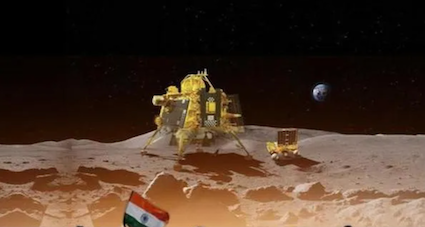Chandrayaan-3’s Vikram Lander successfully made a soft-landing on the Moon’s south pole in an event that will remain etched in not only the history of India but also that of lunar exploration. At 06:04 pm on Tuesday, August 23, 2023, the Indian Space Research Organisation (ISRO) successfully landed its Vikram Lander on Earth’s only natural satellite. The landing is a culmination of years of planning and makes India one among only four nations that have made soft-landings on the moon. The others being the United States, Russia (the Soviet Union when it landed on the Moon) and China.
The landing of Chandrayaan-3 is a poignant redemption. Scientists at ISRO spent nights and days analysing what led to the partial failure of Chandrayaan-2, the spacecraft that failed to make its lunar rendezvous in 2019. A meticulous analysis of data gathered from Chandrayaan-2 culminated in the Chandrayaan-3 effort.
Prime Minister Narendra Modi witnessed the historic event from Johannesburg, South Africa where he is attending the BRICS Summit.
Chandrayaan-3 was launched into space on July 14, 2023. The journey has been arduous. Initially, it was anticipated that the Russian Luna-25 would make a soft-landing on the moon before Chandrayaan-3. But that was not to be. The Russian spacecraft crashed into the Moon ending Roscosmos’ hopes to be the first space agency to land on the south pole. This in turn meant that if Chandrayaan-3 landed successfully, it would make ISRO the only space agency to have managed the feat.
ISRO scientists kept a keen eye on every movement of Chandrayaan-3 and assured a billion-strong nation that all was in order. At around 05:44 pm, ISRO initiated its automatic landing sequence. Twenty minutes of terror followed. Those minutes seemed like a century as Chandrayaan-3’s Vikram Lander slowly made the descent towards the moon, and then exactly at 6:04 pm, the spaceship touched the lunar surface, culminating a 40-day journey and creating history.
Now on the moon’s south pole, a side panel of the lander Vikram will unfold and create a ramp for Pragyan — the rover. Pragyan will touch the Moon’s surface around four hours after landing. After which, for the next 14 days — one lunar day — it will take pictures and collect data moving at a speed of one centimetre per second. The stated purpose of Chandrayaan-3 is to demonstrate safe, soft-landing on the moon, rover movement and then conduct in-situ scientific experiments. The first objective having been realised, it’s now up to Chandrayaan-3 to deliver on the other two.


